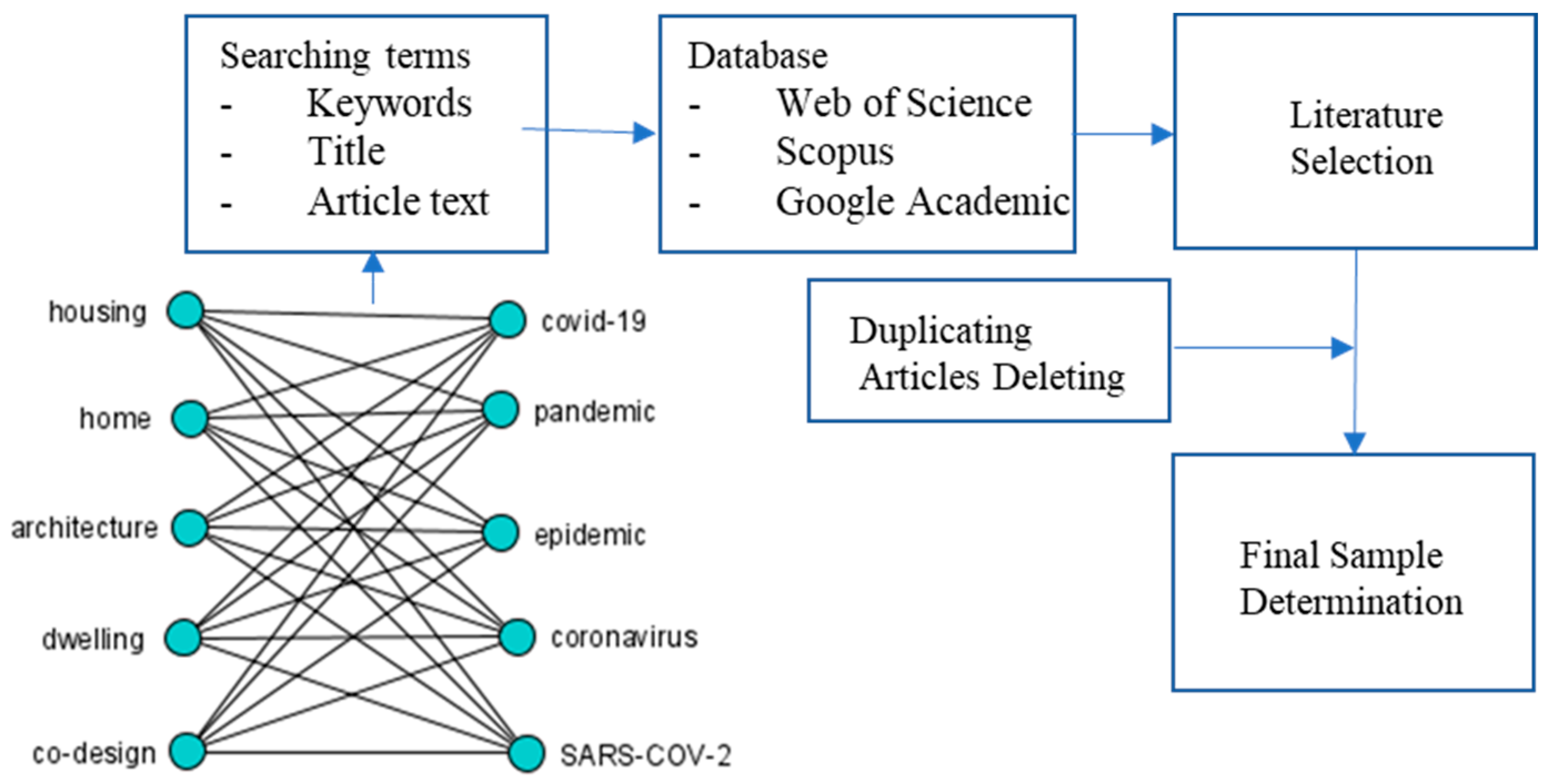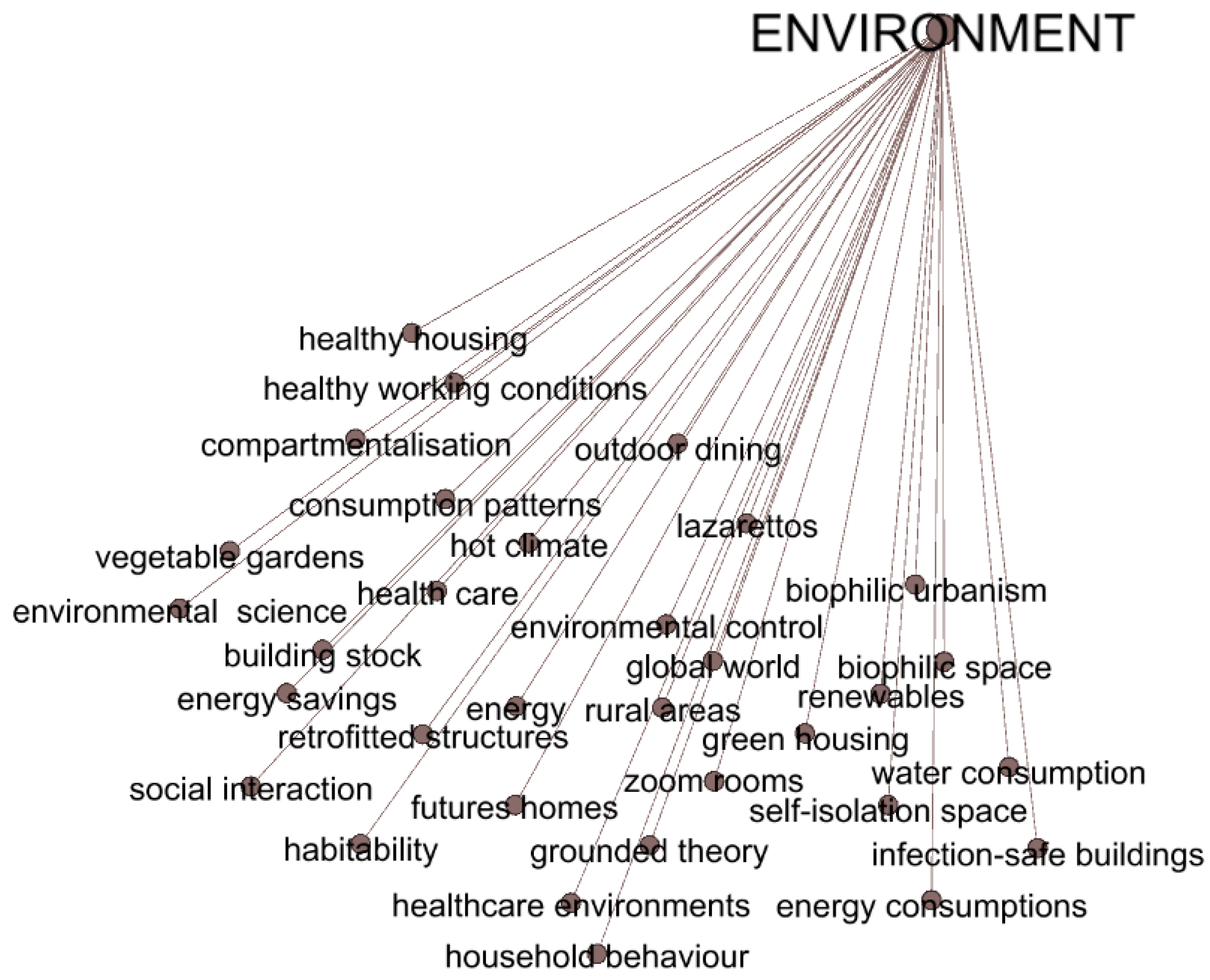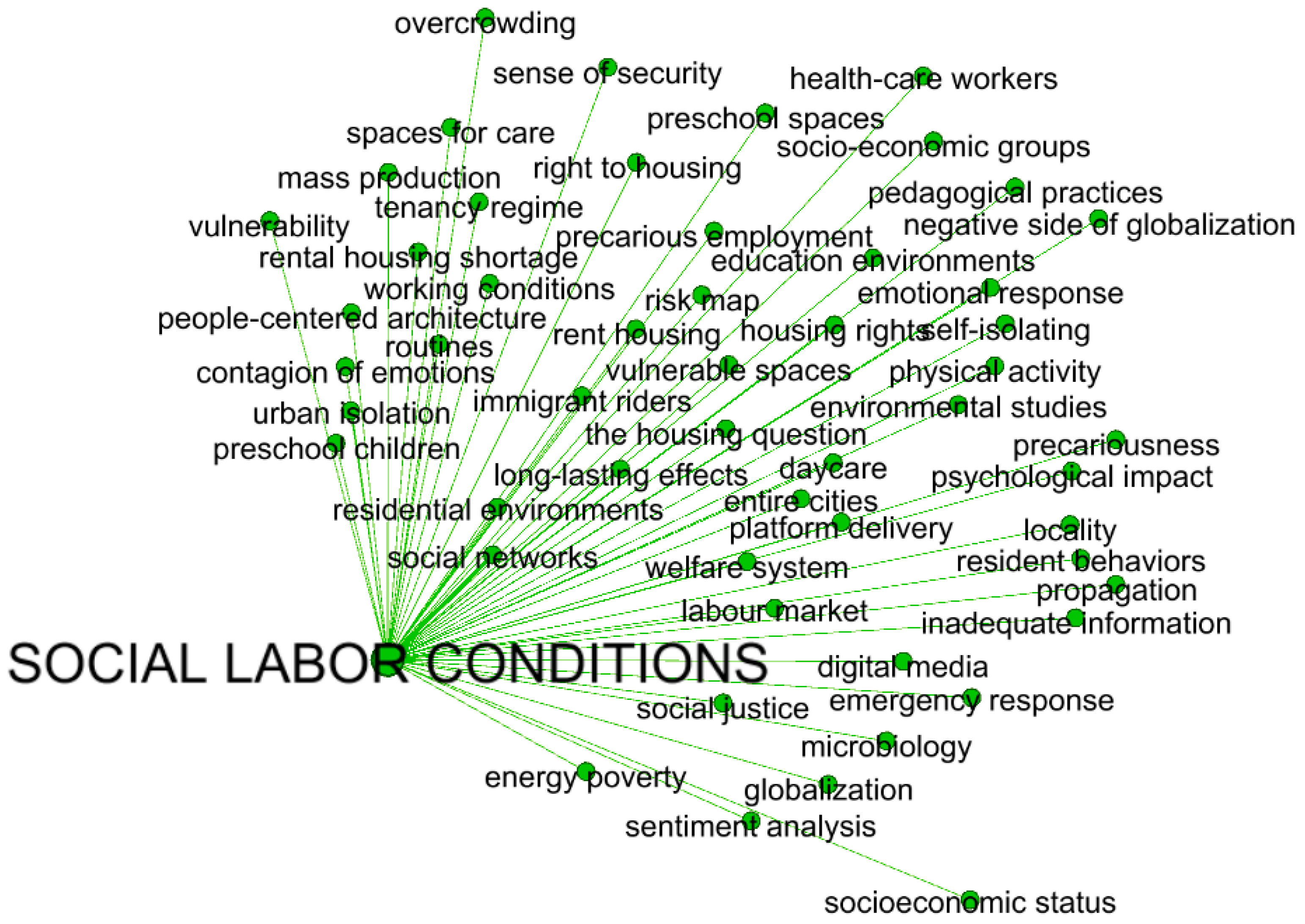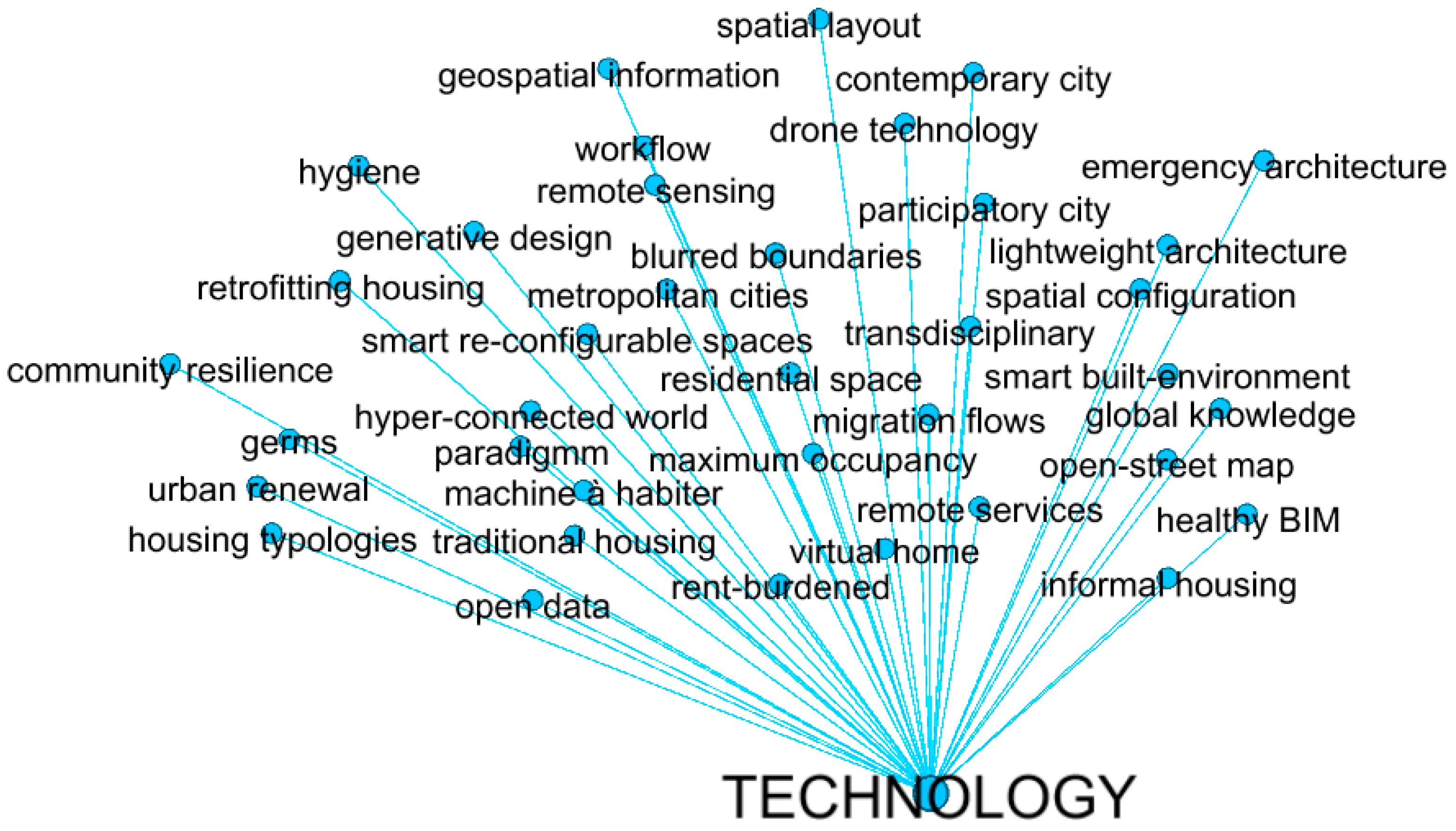Connecting the Dots between Housing Design and COVID-19
Abstract
:1. Introduction
2. Materials and Methods
3. Results
3.1. Classification and Keywords
3.1.1. Architecture Design
3.1.2. Environment
3.1.3. Gender
3.1.4. Health and Prevention
3.1.5. Outdoor Spaces
3.1.6. Social Labor Conditions
3.1.7. Technology
3.2. Authors and Keywords
4. Future Directions
5. Conclusions
Author Contributions
Funding
Institutional Review Board Statement
Informed Consent Statement
Data Availability Statement
Conflicts of Interest
References
- Liu, N.; Xu, Z.; Skare, M. The research on COVID-19 and economy from 2019 to 2020: Analysis from the perspective of bibliometrics. Oeconomia Copernic. 2021, 12, 217–268. [Google Scholar] [CrossRef]
- Javed, B.; Sarwer, A.; Soto, E.B.; Mashwani, Z.-U. Impact of SARS-CoV-2 (Coronavirus) pandemic on public mental health. Front. Public Health 2020, 8, 292. [Google Scholar] [CrossRef] [PubMed]
- Jorge-Huertas, V.D. Collaborative designing of communities: Helsinki and Zurich Pioneers. ACE Archit. City Environ. 2020, 15, 43. [Google Scholar] [CrossRef]
- Popescu Ljungholm, D.; Olah, M.L. Mental health consequences of the COVID-19 crisis on frontline healthcare professionals: Psychological impairments as a result of work-related stress. Psychosociol. Issues Hum. Resour. Manag. 2020, 8, 31–36. [Google Scholar] [CrossRef]
- Campbell, M. What Tuberculosis did for Modernism: The Influence of a Curative Environment on Modernist Design and architecture. Med. Hist. 2005, 49, 463–488. [Google Scholar] [CrossRef] [PubMed] [Green Version]
- Dell’Ovo, M.; Capolongo, S. Architectures for health: Between historical contexts and suburban areas. Tool to support location strategies. TECHNE-J. Technol. Archit. Environ. 2016, 12, 269–276. [Google Scholar]
- Porras-Gallo, M.; Davis, A.R. The Spanish Influenza Pandemic of 1918–1919. In Perspectives from the Iberian Peninsula and the Americas; University of Rochester Press: Rochester, NY, USA, 2014. [Google Scholar]
- Colomina, B. X-ray Architecture; Lars Müller: Zürich, Switzerland, 2019. [Google Scholar]
- Overy, P. Light, Air and Openness. Modern Architecture between the Wars; Thames and Hudson: London, UK, 2007. [Google Scholar]
- Kucharski, A. The Rules of Contagion: Why Things Spread-and Why They Stop; Wellcome Collection: London, UK, 2020. [Google Scholar]
- Paul, J.; Rialp, A. The art of writing literature review: What do we know and what do we need to know? Int. Bus. Rev. 2020, 29, 101717. [Google Scholar] [CrossRef]
- Marabelli, M.; Newell, S. Knowing, power and materiality: A critical review and reconceptualization of absorptive capacity. Int. J. Manag. Rev. 2014, 16, 479–499. [Google Scholar] [CrossRef]
- De Jorge-Huertas, V.; De Jorge-Moreno, J. Mapping urban design literature: A network-based approach. Spatium 2022, 47, 75–83. [Google Scholar] [CrossRef]
- Aggarwal, C.C. An Introduction to Social Network Data Analytics. In Social Network Data Analytics; Aggarwal, C., Ed.; Springer: Boston, MA, USA, 2011. [Google Scholar] [CrossRef]
- Fernández Villa, D. Aplicación de Técnicas de Visualización y Análisis de Redes Para el Estudio de la Producción Colaborativa de Conocimiento. Master’s Thesis, Universidad Complutense de Madrid, Madrid, Spain, 2018. Available online: https://eprints.ucm.es/id/eprint/49776/ (accessed on 10 April 2021).
- Leskovec, J.L.; Lang, K.J.; Dasgupta, A.; Mahoney, M.W. Community structure in large networks: Natural cluster sizes and the absence of large well-defined clusters. Internet Math. 2009, 6, 29–123. [Google Scholar] [CrossRef] [Green Version]
- Jeub, L.G.; Balachandran, P.; Porter, M.A.; Mucha, P.J.; Mahoney, M.W. Think locally, act locally: Detection of small, medium-sized, and large communities in large networks. Phys. Rev. E 2015, 91, 012821. [Google Scholar] [CrossRef] [Green Version]
- Fortunato, S.; Hric, D. Community detection in networks: A user guide. Phys. Rep. 2016, 659, 1–44. [Google Scholar] [CrossRef] [Green Version]
- Quaglio, C.; Todella, E.; Lami, I.M. Adequate Housing and COVID-19: Assessing the Potential for Value Creation through the Project. Sustainability 2021, 13, 10563. [Google Scholar] [CrossRef]
- Hajjar, R.M. Exploring a new housing design paradigm for post pandemic multi-story buildings in Lebanon. Archit. Plan. J. 2021, 27, 1. [Google Scholar] [CrossRef]
- Pinassang, J.; Harsritanto, B.I.; Sari, D.P. What We Can Learn from Vernacular House and COVID-19 Infection? A Review of Mbaru Niang, Flores, Indonesia. In Proceedings of the E3S Web of Conferences, ICENIS 2021, Semarang, Indonesia, 4–5 August 2021; Volume 317, p. 04017. [Google Scholar] [CrossRef]
- Cavus, O.; Uyduran, H.G.; Razzaghmanesh, D.; As, İ. An evolutionary approach for topology finding in flexible and modular housing; PROJECTIONS. In Proceedings of the 26th International Conference of the Association for Computer-Aided Architectural Design Research in Asia (CAADRIA), Hong Kong, China, 29 March–1 April 2021; Volume 1, pp. 231–240. [Google Scholar]
- Bettaieb, D.M.; Alsabban, R. Emerging living styles post-COVID-19: Housing flexibility as a fundamental requirement for apartments in Jeddah. Archnet-IJAR Int. J. Archit. Res. 2020, 15, 28–50. [Google Scholar] [CrossRef]
- Arena, M.; Calabrese, L.; Di Bella, G.; Fiandaca, O.; Minutoli, F.; Lione, R.; Todesco, F. “Modern” suburbs in lockdown: The INA CASA neighbourhood by Filippo Rovigo in Messina. Vitr. Int. J. Archit. Technol. Sustain. 2020, 5, 17–36. [Google Scholar]
- Zarrabi, M.; Yazdanfar, S.-A.; Hosseini, S.-B. COVID-19 and healthy home preferences: The case of apartment residents in Tehran. J. Build. Eng. 2020, 35, 102021. [Google Scholar] [CrossRef]
- D’Alessandro, D.; Gola, M.; Appolloni, L.; Dettori, M.; Fara, G.M.; Rebecchi, A.; Settimo, G.; Capolongo, S. COVID-19 and Living space challenge. Well-being and Public Health recommendations for a healthy, safe, and sustainable housing. Acta Biomed. 2020, 91, 61–75. [Google Scholar]
- De Frutos, F.; Cuerdo-Vilches, T.; Alonso, C.; Martín-Consuegra, F.; Frutos, B.; Oteiza, I.; Navas-Martín, M. Indoor Environmental Quality and Consumption Patterns before and during the COVID-19 Lockdown in Twelve Social Dwellings in Madrid, Spain. Sustainability 2021, 13, 7700. [Google Scholar] [CrossRef]
- Frumkin, H. COVID-19, the Built Environment and Health. Environ. Health Perspect. 2021, 129, 75001. [Google Scholar] [CrossRef]
- Ebrahimpour, M. Proposing a framework of biophilic design principles in hot and arid climate of iran by using grounded theory. Civ. Environ. Eng. 2020, 16, 71–78. [Google Scholar] [CrossRef]
- UN Women. The Shadow Pandemic: Violence against Women during COVID-19. 2021. Available online: https://www.unwomen.org/en/news/in-focus/in-focus-gender-equality-in-covid-19-response/violence-against-women-during-covid-19 (accessed on 10 February 2021).
- Gurney, C.M. Dangerous liaisons? Applying the social harm perspective to the social inequality, housing and health trifecta during the COVID-19 pandemic. Int. J. Hous. Policy 2021, 1, 1–28. [Google Scholar] [CrossRef]
- Rajabifard, A.; Murcio, R.; Iacopini, I.; Vanhoof, M.; Milton, R. COVID-19 Pandemic, Geospatial Information, and Community Resilience; Taylor & Francis Group: Abingdon, UK, 2021. [Google Scholar]
- Moore, C.; Kolencik, J. Acute depression, extreme anxiety, and prolonged stress among COVID-19 frontline healthcare workers. Psychosociol. Issues Hum. Resour. Manag. 2020, 8, 55–60. [Google Scholar] [CrossRef]
- Nuraeny, E.; Larasati, W.L.; Hanifati, K.; Iqbal, M.; Kurniawan, K.R. Kitchen as the Heart of Indonesian Houses: Re-domestication during the COVID-19 pandemic. J. Int. Soc. Study Vernac. Settl. 2021, 8, 19–38. [Google Scholar]
- Tokazhanov, G.; Tleuken, A.; Guney, M.; Turkyilmaz, A.; Karaca, F. How is COVID-19 Experience Transforming Sustainability Requirements of Residential Buildings? A Review. Sustainability 2020, 12, 8732. [Google Scholar] [CrossRef]
- Arroyo, I.; Montesino, N.; Johansson, E.; Yahia, M.W. Social integration through social connection in everyday life. Residents’ experiences during the COVID-19 pandemic in SällBo collaborative housing, Sweden. Archnet-IJAR Int. J. Archit. Res. 2021, 15, 79–97. [Google Scholar] [CrossRef]
- Rogers, D.; Power, E. Housing policy and the COVID-19 pandemic: The importance of housing research during this health emergency. Int. J. Hous. Policy 2020, 20, 177–183. [Google Scholar] [CrossRef]
- Fezi, B. Health engaged architecture in the context of COVID-19. J. Green Build. 2020, 15, 185–212. [Google Scholar] [CrossRef]
- Spennemann, D. Residential architecture in a postpandemic world: Implications of COVID-19 for new construction and for adapting heritage buildings. J. Green Build. 2021, 16, 199–215. [Google Scholar] [CrossRef]
- Brooks, S.K.; Webster, R.K.; Smith, L.E.; Woodland, L.; Wessely, S.; Greenberg, N.; Rubin, G.J. The psychological impact of quarantine and how to reduce it: Rapid review of the evidence. Lancet 2020, 395, 912–920. [Google Scholar] [CrossRef] [Green Version]
- Peters, T.; Halleran, A. How our homes impact our health: Using a COVID-19 informed approach to examine urban apartment housing. Archnet-IJAR Int. J. Archit. Res. 2020, 15, 10–27. [Google Scholar] [CrossRef]
- Suryantini, R.; Atmodiwirjo, P.; Yatmo, Y.A. Toward a healthy home: Investigating food flow and the shift in domestic spatial practice during the COVID-19 pandemic. Hous. Soc. 2020, 50, 4. [Google Scholar] [CrossRef]
- Millán-Jiménez, A.; Herrera-Limones, R.; López-Escamilla, Á.; López-Rubio, E.; Torres-García, M. Confinement, Comfort and Health: Analysis of the Real Influence of Lockdown on University Students during the COVID-19 Pandemic. Int. J. Environ. Res. Public Health 2021, 18, 5572. [Google Scholar] [CrossRef]
- Chan, J.; Zhang, Y. Wither the Sharing City? Built Environ. 2021, 47, 380–391. [Google Scholar] [CrossRef]
- Preece, J.; McKee, K.; Robinson, D.; Flint, J. Urban rhythms in a small home: COVID-19 as a mechanism of exception. Urban Stud. 2021, 2, 1–18. [Google Scholar] [CrossRef]
- Muhyi, M.M.; Adianto, J. Literature Review: The Effects of COVID-19 Pandemic-Driven Home Behavior in Housing Preference. Smart City 2021, 1, 2. Available online: https://scholarhub.ui.ac.id/smartcity/vol1/iss1/2 (accessed on 20 March 2021). [CrossRef]
- Akbari, P.; Yazdanfar, S.-A.; Hosseini, S.-B.; Norouzian-Maleki, S. Housing and Mental Health during Outbreak of COVID-19. J. Build. Eng. 2021, 43, 102919. [Google Scholar] [CrossRef]
- Encinas, F.; Soto-Liebe, K.; Núñez, C.A.A.; González, B.; Bustamante, W.; Schueftan, A.; Ugalde, J.; Blondel, C.; Truffello, R.; Araya, P.; et al. COVID-19 and City: Towards an Integrated Model of Housing, Microbiology, Environment and Urbanism. ACE Archit. City Environ. 2020, 16, 9645. [Google Scholar] [CrossRef]
- Gür, M. Post-pandemic lifestyle changes and their interaction with resident behavior in housing and neighborhoods: Bursa, Turkey. J. Hous. Built Environ. 2021, 37, 823–862. [Google Scholar] [CrossRef]
- Alraouf, A.A. The new normal or the forgotten normal: Contesting COVID-19 impact on contemporary architecture and urbanism. Archnet-IJAR Int. J. Archit. Res. 2021, 15, 167–188. [Google Scholar] [CrossRef]
- Megahed, N.A.; Ehab, M.G. Antivirus-built environment: Lessons learned from COVID-19 pandemic. Sustain. Cities Soc. 2021, 61, 102350. [Google Scholar] [CrossRef]
- Muñoz Carabias, F. Límites precisos difusos. Arquitecturas paradójicas en la era postCOVID. Rita 2020, 14, 110–115. [Google Scholar] [CrossRef]
- Maturana, B.; Salama, A.M.; McInneny, A. Architecture, urbanism and health in a post-pandemic virtual world. Architecture in a postpandemic world. Archnet-IJAR Int. J. Archit. Res. 2021, 15, 1–9. [Google Scholar] [CrossRef]
- Nobile, C.; Puppo, M.E.; Sader, A. Casas, gérmenes y virus. Episodios de eclosión entre la enfermedad y el habitar. Modul. Arquit. CUC 2021, 27, 167–194. [Google Scholar] [CrossRef]
- Dongre, P.; Manuel, M.; Gračanin, D. Re-imagining Indoor Space Utilization in the COVID-19 Pandemic with Smart Re-configurable Spaces (SReS). In Proceedings of the Distributed, Ambient and Pervasive Interactions: 9th International Conference, DAPI 2021, Held as Part of the 23rd HCI International Conference, HCII 2021, Virtual Event, 24–29 July 2021; Springer International Publishing: Berlin/Heidelberg, Germany, 2021. [Google Scholar] [CrossRef]
- Amerio, A.; Brambilla, A.; Morganti, A.; Aguglia, A.; Bianchi, D.; Santi, F.; Costantini, L.; Odone, A.; Costanza, A.; Signorelli, C.; et al. COVID-19 Lockdown: Housing Built Environment’s Effects on Mental Health. Int. J. Environ. Res. Public Health 2020, 17, 5973. [Google Scholar] [CrossRef]
- Kaklauskas, A.; Lepkova, N.; Raslanas, S.; Vetloviene, I.; Milevicius, V.; Sepliakov, J. COVID-19 and Green Housing: A Review of Relevant Literature. Energies 2021, 14, 2072. [Google Scholar] [CrossRef]















| Degree | Modularity | Closeness | Betweenness | |
|---|---|---|---|---|
| air quality | 7 | 0 | 0.53 | 20.45 |
| green space | 7 | 2 | 0.54 | 30.88 |
| lookdown | 6 | 1 | 0.53 | 21.15 |
| housing design | 6 | 0 | 0.53 | 22.64 |
| adaptative architecture | 5 | 0 | 0.50 | 13.36 |
| sustainable architecture | 5 | 2 | 0.47 | 11.63 |
| housing automation | 5 | 2 | 0.51 | 14.79 |
| mental health | 5 | 6 | 0.51 | 16.88 |
| teleworking | 5 | 0 | 0.47 | 11.63 |
| common space | 5 | 0 | 0.51 | 14.55 |
| public housing | 4 | 1 | 0.45 | 9.07 |
| biophilic design | 4 | 2 | 0.49 | 10.44 |
| spatial size | 4 | 3 | 0.49 | 9.19 |
| natural light | 4 | 3 | 0.47 | 8.22 |
| respiratory illness | 4 | 5 | 0.47 | 8.57 |
| dwelling comfort | 4 | 0 | 0.50 | 9.69 |
| everyday life | 4 | 5 | 0.48 | 8.41 |
| flexible housing | 3 | 4 | 0.46 | 4.68 |
Disclaimer/Publisher’s Note: The statements, opinions and data contained in all publications are solely those of the individual author(s) and contributor(s) and not of MDPI and/or the editor(s). MDPI and/or the editor(s) disclaim responsibility for any injury to people or property resulting from any ideas, methods, instructions or products referred to in the content. |
© 2023 by the authors. Licensee MDPI, Basel, Switzerland. This article is an open access article distributed under the terms and conditions of the Creative Commons Attribution (CC BY) license (https://creativecommons.org/licenses/by/4.0/).
Share and Cite
De Jorge-Huertas, V.; De Jorge-Moreno, J. Connecting the Dots between Housing Design and COVID-19. Architecture 2023, 3, 328-343. https://doi.org/10.3390/architecture3020018
De Jorge-Huertas V, De Jorge-Moreno J. Connecting the Dots between Housing Design and COVID-19. Architecture. 2023; 3(2):328-343. https://doi.org/10.3390/architecture3020018
Chicago/Turabian StyleDe Jorge-Huertas, Virginia, and Justo De Jorge-Moreno. 2023. "Connecting the Dots between Housing Design and COVID-19" Architecture 3, no. 2: 328-343. https://doi.org/10.3390/architecture3020018





